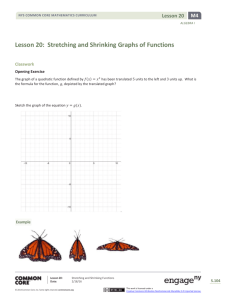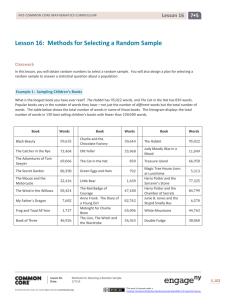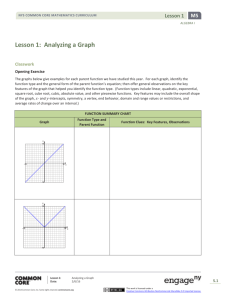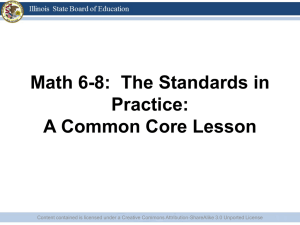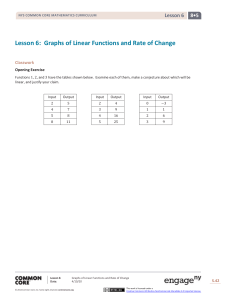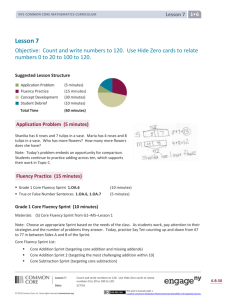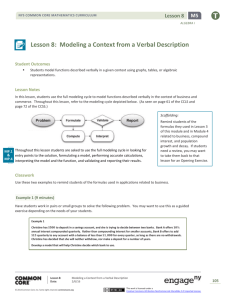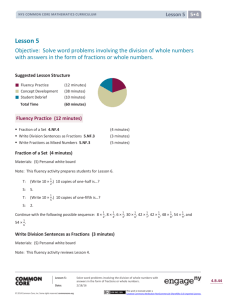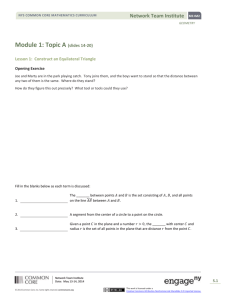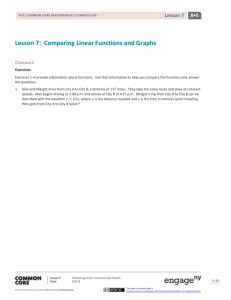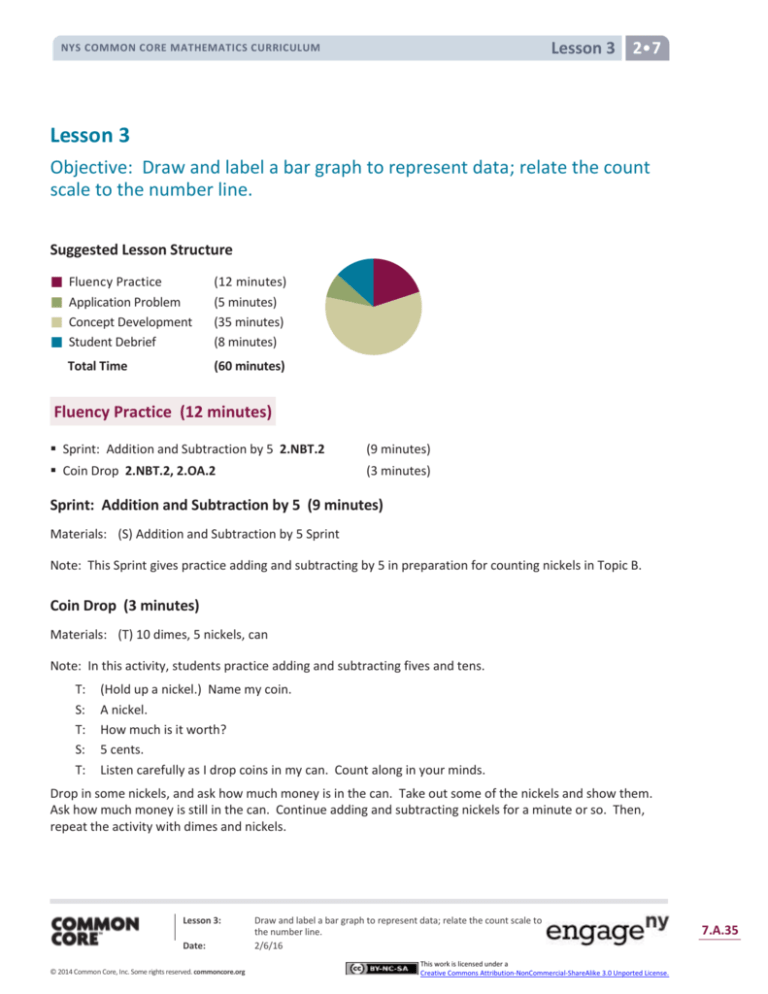
Lesson 3 2 7
NYS COMMON CORE MATHEMATICS CURRICULUM
Lesson 3
Objective: Draw and label a bar graph to represent data; relate the count
scale to the number line.
Suggested Lesson Structure
Fluency Practice
Application Problem
Concept Development
Student Debrief
Total Time
(12 minutes)
(5 minutes)
(35 minutes)
(8 minutes)
(60 minutes)
Fluency Practice (12 minutes)
Sprint: Addition and Subtraction by 5 2.NBT.2
(9 minutes)
Coin Drop 2.NBT.2, 2.OA.2
(3 minutes)
Sprint: Addition and Subtraction by 5 (9 minutes)
Materials: (S) Addition and Subtraction by 5 Sprint
Note: This Sprint gives practice adding and subtracting by 5 in preparation for counting nickels in Topic B.
Coin Drop (3 minutes)
Materials: (T) 10 dimes, 5 nickels, can
Note: In this activity, students practice adding and subtracting fives and tens.
T:
S:
T:
S:
T:
(Hold up a nickel.) Name my coin.
A nickel.
How much is it worth?
5 cents.
Listen carefully as I drop coins in my can. Count along in your minds.
Drop in some nickels, and ask how much money is in the can. Take out some of the nickels and show them.
Ask how much money is still in the can. Continue adding and subtracting nickels for a minute or so. Then,
repeat the activity with dimes and nickels.
Lesson 3:
Date:
© 2014 Common Core, Inc. Some rights reserved. commoncore.org
Draw and label a bar graph to represent data; relate the count scale to
the number line.
2/6/16
This work is licensed under a
Creative Commons Attribution-NonCommercial-ShareAlike 3.0 Unported License.
7.A.35
Lesson 3 2 7
NYS COMMON CORE MATHEMATICS CURRICULUM
Application Problem (5 minutes)
Materials: (T) Tally chart (S) 1 Number of Books Read picture graph (Template 1) per student
a.
Use the tally chart to fill in the picture graph.
b.
Draw a tape diagram to show how many more books Jose read than Laura.
c.
If Jose, Laura, and Linda read 21 books altogether, how many books did Linda read?
d.
Complete the tally chart and the graph.
Note: This problem reviews creating and interpreting picture graphs. It also anticipates one element of the
Concept Development, in which students relate the bars of a graph to the bars of a tape diagram. Prior to the
lesson, cut apart Template 1 so that each student receives one graph.
..
Concept Development (35 minutes)
Materials: (T) Horizontal and vertical bar graphs (Template 2),
Chart 3: Animal Classification and Chart 4: Animal
Habitats (from Lesson 1), completed Template 1
(from Lesson 2) (S) Tape diagrams from Application
Problem, horizontal and vertical bar graphs
(Template 2), personal white board, paper or math
journal
Lesson 3:
Date:
© 2014 Common Core, Inc. Some rights reserved. commoncore.org
Draw and label a bar graph to represent data; relate the count scale to
the number line.
2/6/16
This work is licensed under a
Creative Commons Attribution-NonCommercial-ShareAlike 3.0 Unported License.
7.A.36
Lesson 3 2 7
NYS COMMON CORE MATHEMATICS CURRICULUM
T:
T:
S:
T:
T:
S:
T:
S:
T:
T:
T:
Take your Application Problem and turn it sideways, like mine. (Model as students do the same.)
Talk with your partner: What do you notice about the
picture graph when it’s turned this way?
NOTES ON
Hey! It looks just like a tape diagram! The bars on
MULTIPLE MEANS
the tape diagram show the same amount as the circles
OF ACTION AND
on the graph. They both show that 8 is longer than
EXPRESSION:
5. They both show the difference between 8 and 5,
but you can count the three empty spaces on the
The language of comparison can be
graph.
challenging for English language
learners. Allow them to choose the
(Display completed vertical picture graph [Lesson 2
language they prefer for discourse.
Template 1], pictured below at the right.)
Also, accompany comparative language
Talk with your partner: How can you tell by looking at
such as more, less, taller, and shorter,
the graph which category has more and which has
with illustrative gestures.
less?
The category with the most is the tallest, and the
Template 1 from Lesson 2
category with the least is the shortest.
Does the data change if I turn the graph sideways?
(Rotate graph to horizontal position.)
No!
True! So, we’re learning some interesting things about
graphs. We can change the position of the graph from
vertical to horizontal, and the data stays the same.
(Display Chart 3: Animal Classification from Lesson 1.)
And, we learned we can show the same data in a table
and in a picture graph.
Well, guess what? We can also show the information
another way!
Chart 3 from Lesson 1
Project or draw the horizontal bar graph from Template 2.
Then, pass out student copies of the template, and have
students slide the sheet into their personal white boards.
T:
T:
S:
T:
T:
We’re going to create a bar graph to show the data
from our Animal Classification table.
For our graph to make sense to someone who’s
reading it, it needs to have a title. What is the title
of our chart?
Animal Classification!
We’re showing the same information, just in a
different way, so the title stays the same. Fill in the
title while I do the same. (Record the title as
students do the same.)
How many categories of animals did we classify?
Template 2
Lesson 3:
Date:
© 2014 Common Core, Inc. Some rights reserved. commoncore.org
Draw and label a bar graph to represent data; relate the count scale to
the number line.
2/6/16
This work is licensed under a
Creative Commons Attribution-NonCommercial-ShareAlike 3.0 Unported License.
7.A.37
Lesson 3 2 7
NYS COMMON CORE MATHEMATICS CURRICULUM
S:
T:
T:
S:
T:
S:
T:
T:
S:
T:
S:
MP.6
T:
S:
T:
T:
Four!
NOTES ON
Let’s label those same categories in the same order on
MULTIPLE MEANS
the bar graph. (Record as students do the same.)
OF ENGAGEMENT:
How did we record the number of animals on the
table?
When comparing categories, have
students make the hop with their
We used tally marks.
fingers to show how they add and
And how did we represent the number of each animal
subtract on the number line.
on the picture graph?
Alternatively, call students up to make
live bars to compare categories. For
We drew a picture to represent each animal.
example, to compare bird and fish,
Watch how we represent data on a bar graph. (Fill in
have a row of four students face a row
the scale.)
of three students. Three students from
(Point to the numbers.) First, I fill in the scale. What
each bar can hold hands, making it
are we counting by?
easy to see the difference.
Ones!
Yes. Whisper to your partner what the scale reminds
you of.
It’s like a meter strip. It’s like the numbers on a
ruler. It’s a number line!
The scale tells us that each box equals one, so how
many boxes should we color in for the bird category?
Four boxes!
Color four boxes in the bird row. (Model as students
do the same. Continue in this way to complete the
graph.)
Now, just as with the picture graph, we can use the bar graph to ask
and answer questions.
Pose questions such as those below, and have students write their answers
on paper or in a math journal. Then, invite students to pose questions to the
class based on the picture graph. Invite students to utilize the compare
question sentence frames from Lesson 2 as needed.
How many more mammals than reptiles are there?
How many fewer birds than reptiles are there?
How would the graph change if we added four more birds to the bird
category?
Template 2
Repeat the process to create a bar graph of the data from the Animal Habitats table,
using the second graph (vertical orientation) on Template 2.
After creating the graph, invite partners to ask and answer questions based on the data.
As students demonstrate proficiency creating and interpreting the graph, allow them to move on to the
Problem Set. Continue working with any students who need support.
Lesson 3:
Date:
© 2014 Common Core, Inc. Some rights reserved. commoncore.org
Draw and label a bar graph to represent data; relate the count scale to
the number line.
2/6/16
This work is licensed under a
Creative Commons Attribution-NonCommercial-ShareAlike 3.0 Unported License.
7.A.38
Lesson 3 2 7
NYS COMMON CORE MATHEMATICS CURRICULUM
Problem Set (8 minutes)
Students should do their personal best to complete the
Problem Set within the allotted 10 minutes. For some
classes, it may be appropriate to modify the assignment by
specifying which problems they work on first. Some
problems do not specify a method for solving. Students
should solve these problems using the RDW approach
used for Application Problems.
Student Debrief (8 minutes)
Lesson Objective: Draw and label a bar graph to
represent data; relate the count scale to the number line.
The Student Debrief is intended to invite reflection and
active processing of the total lesson experience.
Invite students to review their solutions for the Problem
Set. They should check work by comparing answers with a
partner before going over answers as a class. Look for
misconceptions or misunderstandings that can be
addressed in the Debrief. Guide students in a
conversation to debrief the Problem Set and process the
lesson.
Any combination of the questions below may be used to
lead the discussion.
Look at the first graph in your Problem Set. What
did you write on this graph that we didn’t put on
our graph yesterday? How do the numbers on
the bottom help us to record data in a bar graph?
Show your partner which part of your graph
shows how many more birds than reptiles there
are.
Look at your neighbor’s habitat graph. Are the
numbers on the scale written horizontally or
vertically?
When you were coloring the boxes to record how
many animal habitats are in the grasslands, did
you count each box, or did you look at the
numbers you wrote? Which strategy would be
faster?
Why are bar graphs good for making
comparisons? Can you tell which category has
Lesson 3:
Date:
© 2014 Common Core, Inc. Some rights reserved. commoncore.org
Draw and label a bar graph to represent data; relate the count scale to
the number line.
2/6/16
This work is licensed under a
Creative Commons Attribution-NonCommercial-ShareAlike 3.0 Unported License.
7.A.39
Lesson 3 2 7
NYS COMMON CORE MATHEMATICS CURRICULUM
more or less without using the scale? How does the scale help you make more precise comparisons?
How does writing numbers on our graphs help us to use tape diagrams? How do bar and picture
graphs help us to draw tape diagrams so that we can see the difference (more than or fewer than)
between groups?
Tell your partner the different types of graphs you know how to use. What are the differences and
similarities between them? Do they all use numbers?
Exit Ticket (3 minutes)
After the Student Debrief, instruct students to complete the Exit Ticket. A review of their work will help with
assessing students’ understanding of the concepts that were presented in today’s lesson and planning more
effectively for future lessons. The questions may be read aloud to the students.
Lesson 3:
Date:
© 2014 Common Core, Inc. Some rights reserved. commoncore.org
Draw and label a bar graph to represent data; relate the count scale to
the number line.
2/6/16
This work is licensed under a
Creative Commons Attribution-NonCommercial-ShareAlike 3.0 Unported License.
7.A.40
Lesson 3 Sprint 2 7
NYS COMMON CORE MATHEMATICS CURRICULUM
Number Correct: _______
A
Addition and Subtraction by 5
1.
0+5=
23.
10 + 5 =
2.
5+5=
24.
15 + 5 =
3.
10 + 5 =
25.
20 + 5 =
4.
15 + 5 =
26.
25 + 5 =
5.
20 + 5 =
27.
30 + 5 =
6.
25 + 5 =
28.
35 + 5 =
7.
30 + 5 =
29.
40 + 5 =
8.
35 + 5 =
30.
45 + 5 =
9.
40 + 5 =
31.
0 + 50 =
10.
45 + 5 =
32.
50 + 50 =
11.
50 – 5 =
33.
50 + 5 =
12.
45 – 5 =
34.
55 + 5 =
13.
40 – 5 =
35.
60 – 5 =
14.
35 – 5 =
36.
55 – 5 =
15.
30 – 5 =
37.
60 + 5 =
16.
25 – 5 =
38.
65 + 5 =
17.
20 – 5 =
39.
70 – 5 =
18.
15 – 5 =
40.
65 – 5 =
19.
10 – 5 =
41.
100 + 50 =
20.
5–5=
42.
150 + 50 =
21.
5+0=
43.
200 – 50 =
22.
5+5=
44.
150 – 50 =
Lesson 3:
Date:
© 2014 Common Core, Inc. Some rights reserved. commoncore.org
Draw and label a bar graph to represent data; relate the count scale to
the number line.
2/6/16
This work is licensed under a
Creative Commons Attribution-NonCommercial-ShareAlike 3.0 Unported License.
7.A.41
Lesson 3 Sprint 2 7
NYS COMMON CORE MATHEMATICS CURRICULUM
Number Correct: _______
B
Improvement: _______
Addition and Subtraction by 5
5+0=
23.
10 + 5 =
2.
[KEY] 5 + 5 =
24.
15 + 5 =
3.
5 + 10 =
25.
20 + 5 =
4.
5 + 15 =
26.
25 + 5 =
5.
5 + 20 =
27.
30 + 5 =
6.
5 + 25 =
28.
35 + 5 =
7.
5 + 30 =
29.
40 + 5 =
8.
5 + 35 =
30.
45 + 5 =
9.
5 + 40 =
31.
50 + 0 =
10.
5 + 45 =
32.
50 + 50 =
11.
50 – 5 =
33.
5 + 50 =
12.
45 – 5 =
34.
5 + 55 =
13.
40 – 5 =
35.
60 – 5 =
14.
35 – 5 =
36.
55 – 5 =
15.
30 – 5 =
37.
5 + 60 =
16.
25 – 5 =
38.
5 + 65 =
17.
20 – 5 =
39.
70 – 5 =
18.
15 – 5 =
40.
65 – 5 =
19.
10 – 5 =
41.
50 + 100 =
20.
5–5=
42.
50 + 150 =
21.
0+5=
43.
200 – 50 =
22.
5+5=
44.
150 – 50 =
1.
Lesson 3:
Date:
© 2014 Common Core, Inc. Some rights reserved. commoncore.org
Draw and label a bar graph to represent data; relate the count scale to
the number line.
2/6/16
This work is licensed under a
Creative Commons Attribution-NonCommercial-ShareAlike 3.0 Unported License.
7.A.42
Lesson 3 Problem Set 2 7
NYS COMMON CORE MATHEMATICS CURRICULUM
Name
Date
1. Complete the bar graph below using data provided in
the table. Then, answer the questions about the
data.
Animal Classification
Birds Fish Mammals Reptiles
6
5
11
__
__
__
3
Title: _______________________________
0
__
__
__
__
__
__
__
__
__
a. How many more animals are birds than reptiles? ______
b. How many more birds and mammals are there than fish and reptiles? ______
c. How many fewer animals are reptiles and fish than mammals? ______
d. Write and answer your own comparison question based on the data.
Question: ____________________________________________________
Answer: _____________________________________________________
Lesson 3:
Date:
© 2014 Common Core, Inc. Some rights reserved. commoncore.org
Draw and label a bar graph to represent data; relate the count scale to
the number line.
2/6/16
This work is licensed under a
Creative Commons Attribution-NonCommercial-ShareAlike 3.0 Unported License.
7.A.43
Lesson 3 Problem Set 2 7
NYS COMMON CORE MATHEMATICS CURRICULUM
2. Complete the bar graph below using data
provided in the table.
Animal Habitats
Desert
Arctic
Grassland
Title: _______________________________
14
13
12
11
10
9
8
7
6
5
4
3
2
1
0
_____
_____
_____
a. How many more animal habitats are in the grassland and arctic combined than in
the desert? ____
b. If 3 more grassland animals and 4 more arctic animals are added to the graph,
how many grassland and arctic animals would there be? _____
c. If 3 animals were removed from each category, how many animals would there
be? _____
d. Write your own comparison question based on the data and answer it.
Question: ____________________________________________________
Answer: _____________________________________________________
Lesson 3:
Date:
© 2014 Common Core, Inc. Some rights reserved. commoncore.org
Draw and label a bar graph to represent data; relate the count scale to
the number line.
2/6/16
This work is licensed under a
Creative Commons Attribution-NonCommercial-ShareAlike 3.0 Unported License.
7.A.44
Lesson 3 Exit Ticket 2 7
NYS COMMON CORE MATHEMATICS CURRICULUM
Name
Date
Complete the bar graph below using data provided in the
table. Then, answer the questions about the data.
Animal Classification
Birds Fish Mammals Reptiles
7
12
8
6
Title: _________________________________
0
__
__
__
__
__
__
__
__
__
__ __ __ __ __
a. How many more animals are fish than reptiles? ______
b. How many more fish and mammals are there than birds and reptiles? ______
Lesson 3:
Date:
© 2014 Common Core, Inc. Some rights reserved. commoncore.org
Draw and label a bar graph to represent data; relate the count scale to
the number line.
2/6/16
This work is licensed under a
Creative Commons Attribution-NonCommercial-ShareAlike 3.0 Unported License.
7.A.45
Lesson 3 Homework 2 7
NYS COMMON CORE MATHEMATICS CURRICULUM
Name
Date
1. Complete the bar graph below using data
provided in the table. Then, answer the
questions about the data.
Various Animal Coverings at Jake’s Pet Shop
Fur
Feathers
Shells
Scales
12
9
8
11
Title: _________________________________
0
__ __
__
__
__
__
__
__ __
__ __ __ __ __
a. How many more animals have fur than shells? ______
b. Which pair of categories has more, fur and feathers or shells and scales? (Circle
one.) How much more? ____
c. Write and answer your own comparison question based on the data.
Question: ____________________________________________________
Answer: _____________________________________________________
Lesson 3:
Date:
© 2014 Common Core, Inc. Some rights reserved. commoncore.org
Draw and label a bar graph to represent data; relate the count scale to
the number line.
2/6/16
This work is licensed under a
Creative Commons Attribution-NonCommercial-ShareAlike 3.0 Unported License.
7.A.46
Lesson 3 Homework 2 7
NYS COMMON CORE MATHEMATICS CURRICULUM
2. Complete the bar graph below using data
provided in the table.
City Shelter Animal Diets
Meat Only
Plants Only
Meat and Plants
Title: _______________________________
14
13
12
11
10
9
8
7
6
5
4
3
2
1
0
_____
_____
_____
a. How many total animals are in the city shelter? _____
b. How many more meat and plant-eating animals are there than meat only? _____
c. If 3 animals were removed from each category, how many animals would there
be? ____
d. Write your own comparison question based on the data, and answer it.
Question: ____________________________________________________
Answer: _____________________________________________________
Lesson 3:
Date:
© 2014 Common Core, Inc. Some rights reserved. commoncore.org
Draw and label a bar graph to represent data; relate the count scale to
the number line.
2/6/16
This work is licensed under a
Creative Commons Attribution-NonCommercial-ShareAlike 3.0 Unported License.
7.A.47
NYS COMMON CORE MATHEMATICS CURRICULUM
Lesson 3 Template 1 2 7
number of books read picture graphs
Lesson 3:
Date:
© 2014 Common Core, Inc. Some rights reserved. commoncore.org
Draw and label a bar graph to represent data; relate the count scale to
the number line.
2/6/16
This work is licensed under a
Creative Commons Attribution-NonCommercial-ShareAlike 3.0 Unported License.
7.A.48
Lesson 3 Template 2 2 7
NYS COMMON CORE MATHEMATICS CURRICULUM
0 __
__ __
__
__ __ __
__
__ __
__ __ __ __
Title: ______________________________
14
13
12
11
10
9
8
7
6
5
4
3
2
1
0
_____
_____
_____
horizontal and vertical bar graphs
Lesson 3:
Date:
© 2014 Common Core, Inc. Some rights reserved. commoncore.org
Draw and label a bar graph to represent data; relate the count scale to
the number line.
2/6/16
This work is licensed under a
Creative Commons Attribution-NonCommercial-ShareAlike 3.0 Unported License.
7.A.49



